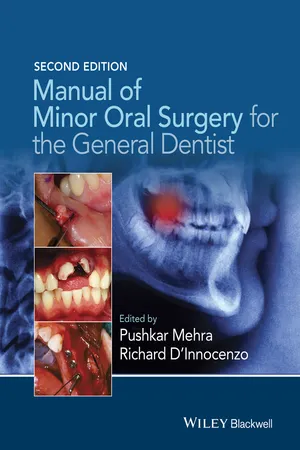
- English
- ePUB (mobile friendly)
- Available on iOS & Android
Manual of Minor Oral Surgery for the General Dentist
About This Book
The Manual of Minor Oral Surgery for the General Dentist, Second Edition continues the aim of providing clear and practical guidance to common surgical procedures encountered in general practice. Fully revised and updated with three additional chapters, the book approaches each procedure through detailed, step-by-step description and illustration. Ideal for general dental practitioners and students, the book is an indispensible tool for planning, performing, and evaluating a range of surgical procedures in day-to-day practice.
The Manual of Minor Oral Surgery for the General Dentist begins with an expanded chapter on patient evaluation and history taking and a new chapter on managing the patient with medical comorbidities. It also address infections and sedation besides procedural chapters on such topics as third molar extractions, preprosthetic surgery, surgical implantology, crown-lengthening, and biopsy of oral lesions.
Frequently asked questions
Information
CHAPTER 1
Patient Evaluation and History Taking
Introduction
Medical history

Cardiovascular system
| BP Classification | Systolic BP (mmHg) | Diastolic BP (mmHg) |
| Normal | <120 | <80 |
| Prehypertensive | 120–139 | 80–89 |
| Stage 1 hypertension | 140–159 | 90–99 |
| Stage 2 hypertension | ≥160 | ≥1... |
Table of contents
- Cover
- Title page
- Table of Contents
- Contributors
- Preface
- CHAPTER 1: Patient Evaluation and History Taking
- CHAPTER 2: Management of the Patient with Medical Comorbidities
- CHAPTER 3: Minimal Sedation for Oral Surgery and Other Dental Procedures
- CHAPTER 4: Surgical Extractions
- CHAPTER 5: Third Molar Extractions
- CHAPTER 6: Pre-prosthetic Oral Surgery
- CHAPTER 7: Evaluation and Biopsy Technique for Oral Lesions
- CHAPTER 8: Surgical Implantology
- CHAPTER 9: Hard-Tissue Augmentation for Dental Implants
- CHAPTER 10: Soft Tissue Surgery for Dental Implants
- CHAPTER 11: Surgical Crown Lengthening
- CHAPTER 12: Endodontic Periradicular Microsurgery
- CHAPTER 13: Dentoalveolar Trauma
- CHAPTER 14: Orofacial Infections
- CHAPTER 15: Complications of Dentoalveolar Surgery
- Index
- End User License Agreement